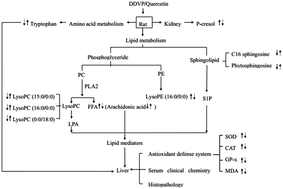A metabonomic analysis of the effect of quercetin on toxicity induced by chronic exposure to low-level dichlorvos in rat plasma†
Abstract
A previous study of ours has reported that chronic exposure to low-level dichlorvos (DDVP, 7.2 mg per kg bw) damages the liver, interferes with fatty acid metabolism, and disturbs the antioxidant defense system in rats. This study aims to investigate whether or not quercetin can protect against DDVP-induced toxicity through metabonomics and to elucidate the mechanism underlying this protective effect. Rats were randomly assigned into the control group, DDVP-treated group, quercetin-treated group, and quercetin plus DDVP-treated group. DDVP and quercetin were administered to the rats daily via drinking water and gavage, respectively, continuously for 90 d. The metabonomic profiles of rat plasma were analyzed using ultra-performance liquid chromatography-mass spectrometry. Finally, 11 metabolites were identified, including those of quercetin, isorhamnetin, and quercetin-3-glucuronide. The 11 metabolites showed significant changes in some treatment groups compared with the control group. Arachidonic acid, phytosphingosine, and C16 sphinganine significantly decreased while p-cresol, lysoPE (16:0/0:0), lysoPC (15:0/0:0), lysoPC (16:0/0:0), lysoPC (0:0/18:0), and tryptophan significantly increased in the DDVP-treated group compared with the control group. The tendency of the aforementioned metabolites to change was significantly ameliorated in the high-dose quercetin (50 mg per kg bw per day) plus DDVP-treated group compared with the DDVP-treated group. However, the levels of these metabolites in the high-dose quercetin plus DDVP-treated group were still significantly different from those in the control group. The results indicate that high-dose quercetin (50 mg per kg bw per day) elicits a partial protective effect on DDVP-induced toxicity. The histopathology of the liver tissues was consistent with the above results. Quercetin demonstrated regulatory effects on the metabolism of lipids and amino acids, the antioxidant defense system, etc. Therefore, increasing the daily intake of quercetin can ameliorate the toxicity induced by chronic exposure to low-level DDVP residue in food and/or water.


 Please wait while we load your content...
Please wait while we load your content...